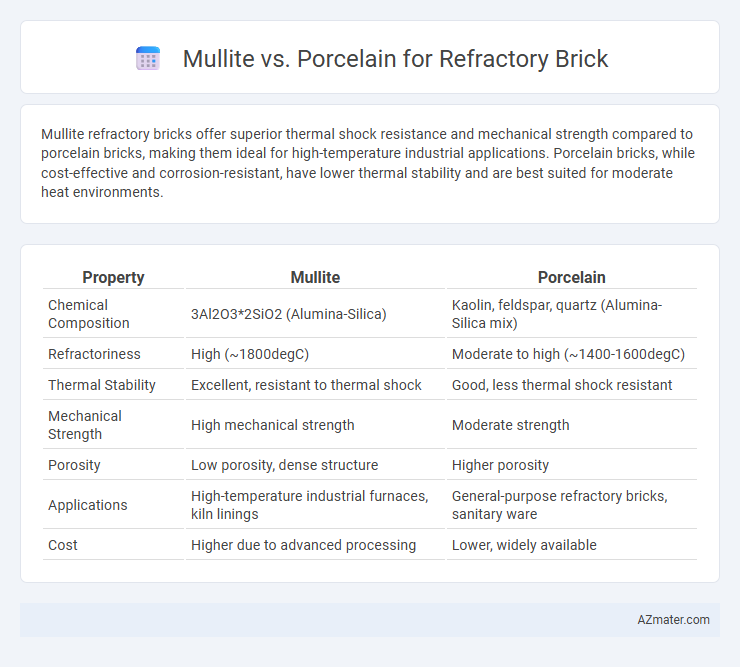Mullite refractory bricks offer superior thermal shock resistance and mechanical strength compared to porcelain bricks, making them ideal for high-temperature industrial applications. Porcelain bricks, while cost-effective and corrosion-resistant, have lower thermal stability and are best suited for moderate heat environments.
Table of Comparison
| Property | Mullite | Porcelain |
|---|---|---|
| Chemical Composition | 3Al2O3*2SiO2 (Alumina-Silica) | Kaolin, feldspar, quartz (Alumina-Silica mix) |
| Refractoriness | High (~1800degC) | Moderate to high (~1400-1600degC) |
| Thermal Stability | Excellent, resistant to thermal shock | Good, less thermal shock resistant |
| Mechanical Strength | High mechanical strength | Moderate strength |
| Porosity | Low porosity, dense structure | Higher porosity |
| Applications | High-temperature industrial furnaces, kiln linings | General-purpose refractory bricks, sanitary ware |
| Cost | Higher due to advanced processing | Lower, widely available |
Introduction to Mullite and Porcelain in Refractory Applications
Mullite and porcelain are key materials in refractory brick production, distinguished by their composition and thermal properties. Mullite, an alumino-silicate mineral known for high melting point and excellent thermal stability, is favored in high-temperature industrial furnaces for its mechanical strength and resistance to thermal shock. Porcelain, composed primarily of kaolin and feldspar, offers good thermal insulation and chemical resistance but generally operates better in moderate-temperature environments compared to mullite-based refractories.
Chemical Composition and Structure Comparison
Mullite refractory bricks primarily consist of 3Al2O3*2SiO2, exhibiting high alumina content (approximately 70-75%) and a crystalline orthorhombic structure that provides excellent thermal stability and low thermal expansion. Porcelain refractory bricks contain a higher proportion of silica (SiO2) and kaolin clay, resulting in a glassy phase with less alumina (around 40-50%) and a predominantly amorphous structure, which affects their mechanical strength under high temperatures. The superior chemical composition and interlocking needle-like mullite crystals enhance resistance to slag corrosion and thermal shock compared to the less dense, more porous porcelain bricks.
Thermal Resistance and Insulation Properties
Mullite refractory bricks exhibit superior thermal resistance due to their high alumina content, enabling them to withstand temperatures up to 1,850degC while maintaining structural integrity. Porcelain bricks, although durable, have lower thermal resistance, typically up to 1,200degC, making them less suitable for extreme heat applications. The insulation properties of mullite bricks are enhanced by their porous microstructure, providing better thermal shock resistance and energy efficiency compared to the denser, less insulating porcelain bricks.
Mechanical Strength and Durability
Mullite refractory bricks offer superior mechanical strength and thermal shock resistance compared to porcelain bricks, making them ideal for high-temperature industrial applications. The high alumina content in mullite contributes to its low thermal expansion and enhanced durability under cyclic heating conditions. Porcelain bricks, although mechanically strong in moderate environments, lack the abrasion resistance and long-term stability that mullite provides in rigorous refractory settings.
Manufacturing Processes: Mullite vs Porcelain Bricks
Mullite refractory bricks are manufactured through high-temperature sintering of alumino-silicate raw materials, producing a dense microstructure with excellent thermal stability and corrosion resistance. Porcelain bricks are created by firing a mixture of kaolin, feldspar, and quartz at lower temperatures than mullite, resulting in a vitreous, chemically inert material with good mechanical strength. The differences in raw materials and firing temperatures significantly influence the performance of these bricks under extreme thermal and chemical conditions in refractory applications.
Cost Analysis and Economic Considerations
Mullite refractory bricks generally offer higher thermal stability and longer service life compared to porcelain bricks, but their initial cost is significantly higher due to complex manufacturing processes and raw material expenses. Porcelain bricks tend to be more economical upfront, making them suitable for applications with moderate thermal demands and budget constraints, though they may require more frequent replacement, increasing long-term costs. Evaluating lifespan, operational efficiency, and maintenance frequency is essential for an accurate economic comparison between mullite and porcelain refractory bricks in industrial applications.
Performance in High-Temperature Environments
Mullite refractory bricks exhibit superior thermal shock resistance and mechanical strength at temperatures exceeding 1700degC, making them ideal for high-temperature industrial applications. Porcelain bricks, while offering good electrical insulation and moderate thermal stability up to around 1300degC, lack the advanced durability and phase stability present in mullite under extreme heat conditions. The high alumina content in mullite contributes to its exceptional resistance against slag infiltration and thermal expansion, outperforming porcelain bricks in prolonged, high-temperature environments.
Typical Industrial Applications
Mullite refractory bricks exhibit exceptional thermal shock resistance and chemical stability, making them ideal for use in glass furnaces, petrochemical reactors, and cement kilns where exposure to high temperatures and corrosive environments is common. Porcelain refractory bricks are favored in applications requiring superior electrical insulation and mechanical strength, such as in electric furnace linings and kiln furniture for ceramics production. Industrial sectors prioritize mullite for its durability in molten metal handling and porcelain for precision in high-voltage electrical components, ensuring optimal performance in their respective operating conditions.
Environmental Impact and Sustainability
Mullite refractory bricks exhibit superior environmental benefits due to their higher thermal stability and longer lifespan, which reduces the frequency of replacements and waste generation. Porcelain bricks, often produced using kaolin clay, consume more energy during manufacturing and have lower thermal resistance, leading to increased energy use in industrial applications. Sustainable practices favor mullite bricks as they contribute to lower carbon emissions and enhance resource efficiency in high-temperature environments.
Conclusion: Choosing the Right Material for Refractory Bricks
Mullite refractory bricks offer superior thermal shock resistance and chemical stability, making them ideal for high-temperature industrial applications requiring durability and longevity. Porcelain bricks provide excellent electrical insulation and smooth surface finish, but they typically lack the high-temperature resilience of mullite. Selecting the right material depends on operational temperature, mechanical stress, and chemical exposure, with mullite preferred for extreme conditions and porcelain suited for moderate thermal environments.

Infographic: Mullite vs Porcelain for Refractory Brick
 azmater.com
azmater.com